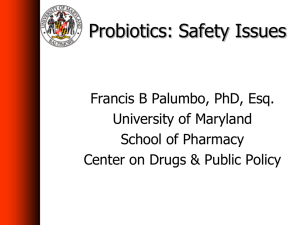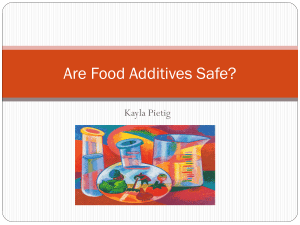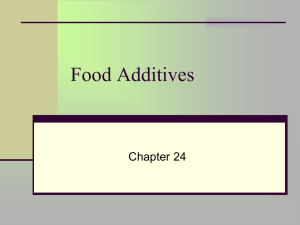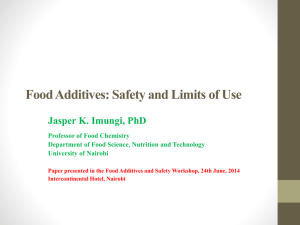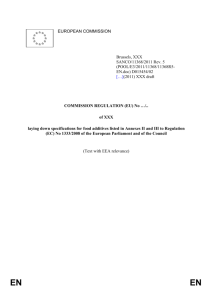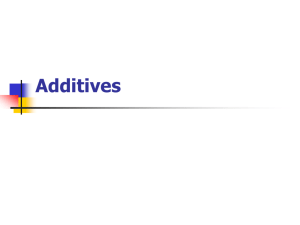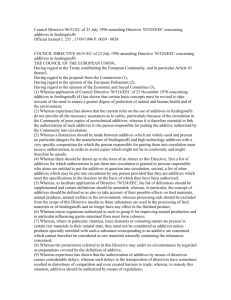FdSc 3010 – Food Policy & Regulation Last Class: Egg Safety Rule
advertisement
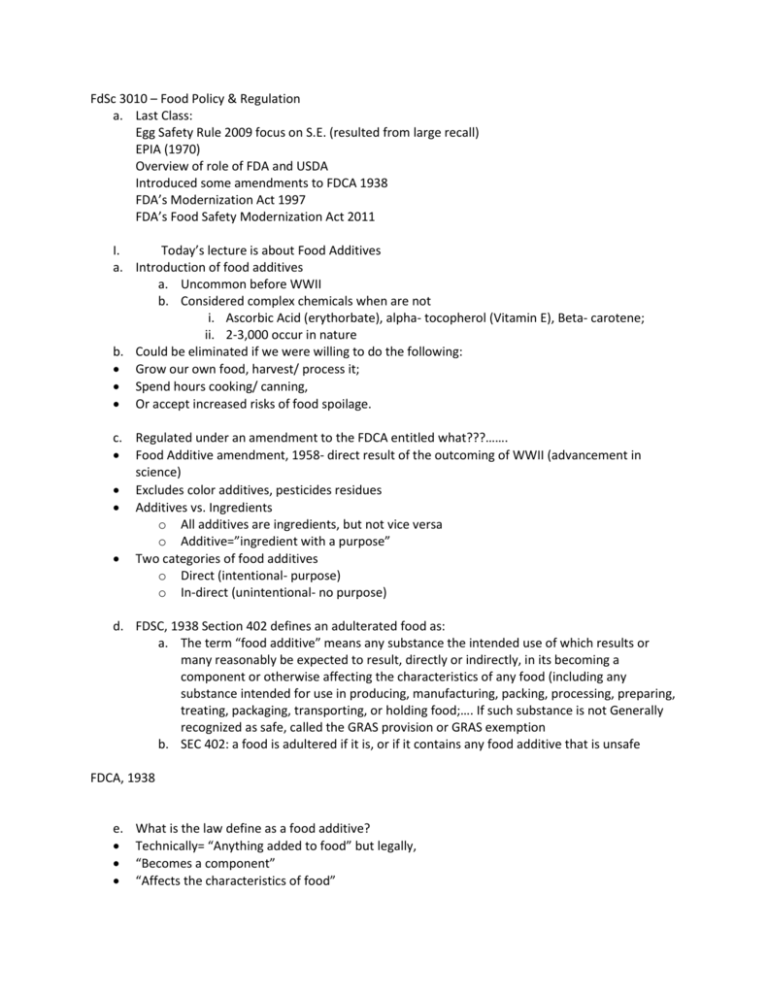
FdSc 3010 – Food Policy & Regulation a. Last Class: Egg Safety Rule 2009 focus on S.E. (resulted from large recall) EPIA (1970) Overview of role of FDA and USDA Introduced some amendments to FDCA 1938 FDA’s Modernization Act 1997 FDA’s Food Safety Modernization Act 2011 I. Today’s lecture is about Food Additives a. Introduction of food additives a. Uncommon before WWII b. Considered complex chemicals when are not i. Ascorbic Acid (erythorbate), alpha- tocopherol (Vitamin E), Beta- carotene; ii. 2-3,000 occur in nature b. Could be eliminated if we were willing to do the following: Grow our own food, harvest/ process it; Spend hours cooking/ canning, Or accept increased risks of food spoilage. c. Regulated under an amendment to the FDCA entitled what???……. Food Additive amendment, 1958- direct result of the outcoming of WWII (advancement in science) Excludes color additives, pesticides residues Additives vs. Ingredients o All additives are ingredients, but not vice versa o Additive=”ingredient with a purpose” Two categories of food additives o Direct (intentional- purpose) o In-direct (unintentional- no purpose) d. FDSC, 1938 Section 402 defines an adulterated food as: a. The term “food additive” means any substance the intended use of which results or many reasonably be expected to result, directly or indirectly, in its becoming a component or otherwise affecting the characteristics of any food (including any substance intended for use in producing, manufacturing, packing, processing, preparing, treating, packaging, transporting, or holding food;…. If such substance is not Generally recognized as safe, called the GRAS provision or GRAS exemption b. SEC 402: a food is adultered if it is, or if it contains any food additive that is unsafe FDCA, 1938 e. What is the law define as a food additive? Technically= “Anything added to food” but legally, “Becomes a component” “Affects the characteristics of food” Excludes GRAS substances f. The law recognizes three classes of direct food additives which are: Food additives (covered under amendment) Food additives generally recognized as safe (GRAS)- label FDA uses for components that are: o Known safe additives o A long “history of safe use in food before 1958 or based on published scientific evidence” Additives with “prior approval” o Also exempt and referred to as “Prior- sanctioned substances” g. Role of FDA and USDA for GRAS and PSS Continue to monitor GRAS and Prior- Sanctioned Substances with respect to new scientific evidence If new evidence shows unsafe, will prohibit Safe= “reasonably certainty in the minds of competent scientists” that it is not harmful Defines “food additive” w/ GRAS exemption and w/ PSS exemption Requires premarket approval of new uses of food additives (FDA Establishes the standard of review (No permanent approval) Establishes the standard of safety (Company.) h. 5 Main reasons for Direct Food Additives 1. 2. 3. 4. 5. Maintain consistency (emulsifiers, stabilizers, thickeners, anti-caking agents, etc.) Improve or maintain nutritional value (fortification/ enrichment of milk, flour, cereals, etc.) Maintain palatability and wholesomeness (preservatives against spoilage- microbes or air) Provide leavening or control acidity/ alkalinity (baked goods) Enhanced flavor (spices, flavorings) i. Food Additives – Not Allowed To: Disguise bad or inferior processes Disguise damaged, spoiled, inferior foods Deceive consumers Substantially reduce important nutrients Replace good sanitation practices Be used in amount larger than the min required to achieve desired effect j. What are food irradiation: Ionizing radiation= beta, gamma, x-rays Preserves and prolongs shelf-life Consider irradiation as an additive Some countries view it as a “process”; others view it as a food additive Unit= Gray (Gy) Label- “treated with irradiation” Perishable foods (1-10 kGy) Spices/ cereals (8-30 kGy) Complete sterilization (20-70 kGy) k. What about Indirect Food Additives A database on indirect food additves has been generated by FDA’s CFSAN o Info on over 3000 substances used in food contact substances o Falls under ongoing program called “PAFA” (priority-based assessment of food additives) o Adhesives, components of coating, paper, paperboard, polymers, processing aids Trace amount May come in contact with food as a part of packaging or processing equipment This web link refers to that exemptionhttp://www.fda.gov/Food/FoodIngredientsPackaging/ucm115333.htm 21CFR 170.39 Threshold of Regulation Exemption” “A substance used in a food contact articles that migrates or that may be expected to migrate into food will be exempted from regulation as a food additive because it becomes a component of food at levels that are below the threshold or regulation if: Not carcinogenic to humans or animals Present no other health or safety concern (regulation list specific dietary conclusion of less than or equal to 0.5 ppb) Has not technical effect on the food No effect on environment If FDA receives new information that shows this…decline exemption II. Color Additives a. Also an amendment to FDCA, 1938 entitled Color Additive amendment, 1960 b. Definition of a color additive is: Dye, pigment or substance that can impart color when added or applied to a food, drug, cosmetic or to human body c. Used in food because: Increase acceptability Offset color loss during handling/ processing Correct color variations (uniformity) Requires FDA approval Requires manufacture to prove safety for the way it will be used d. Delaney Clause is: Prohibit use or approval of either if found to cause cancer in humans or animals e. How do you get approval for a new food or color additive? FDA begins with assumption that new food additives are undafe Petition FDA for approval Petition must: o Include a full report of all safety investigations (animal and toxicological) FDA then: o Consider composition and prop of substance, amount likely to be consumed, probability for long term effects and various other safety factors o “Best scientific knowledge available” If approved, FDA will: (no objection) o Type of food it can be used in o Maximum amount allowed o Labeling
